Three generations of the Skoda Superb
With the third generation of the Skoda Superb launched, we revisit the ancestry of what has come to be one of India’s favourite luxury cars.
Published On Jul 14, 2016 07:00:00 AM
1,09,625 Views
Follow us on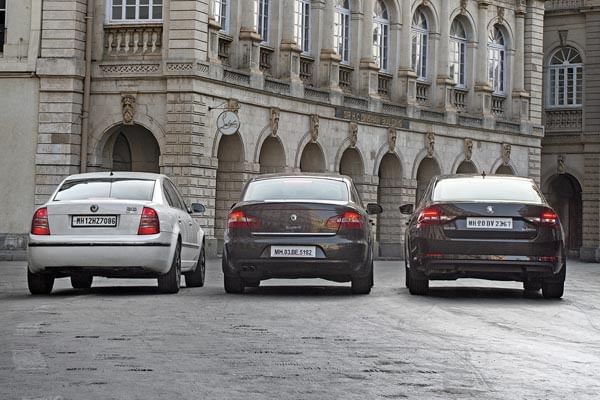

Large swathes of wood looked expensive, but were a bit garish.
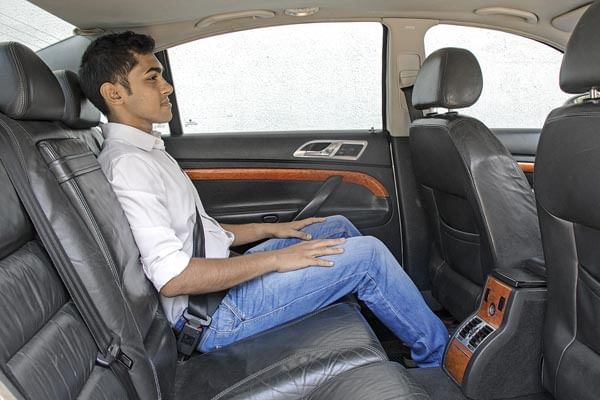
The rear of the first-gen set a benchmark in those days; the sumptuous leather helped.

Lots of chrome and wood made the second-gen Superb look upmarket.
Space is probably the ultimate luxury. Think about it. Yachts are classified in feet, estates are measured in acres and when you talk mansions, you normally count living rooms, bedrooms and state rooms. The ‘bigger is better’ yardstick is also commonly used when it comes to luxury cars – small cars after all are cheap, and large ones are expensive; that’s just the way it is. What’s unique about the Superb is that it is a car that breaks the mould when it comes to the price-to-size ratio. While most of its competition follows the same template in terms of price versus size, the Superb is just massive on the outside and the inside. And that gives it an edge.
Built on specially modified platforms over the years, which include stretched rear doors and longer wheelbases, the key to the success of the Superb has been its mighty interior space and huge levels of comfort.
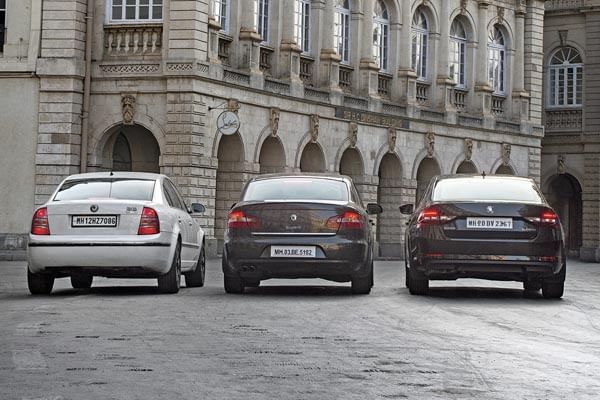
The first Superb of the modern generation, however, was not born of natural model progression, but of necessity. Skoda simply wanted to make a car for the Czech President, and it hasn’t looked back since.
But what are the various generations really like when you examine and experience them? To answer that, we bring three generations of the Superb together and drive them back-to-back.
The Template is set:
B5 (2004-2008)

The first-generation Skoda Superb, even more than a decade on, still looks attractive in the early morning sun. Unadorned by superfluous details, the clean profile lends it a timeless quality. Yes, the headlights and grille seem to have aged, and so have some other bits, but the graceful lines of the car still stand out. And what catches your eye is the astonishing length, the long, sloping bonnet and the stretched-out rear.
This B5 was built on a VW Passat platform that had been stretched a full 95mm between the wheels. An interesting twist here is that the Passat itself was originally based on an Audi A4, and because the Audi uses the quattro system and, as a result, has its engines placed longitudinally, the first-gen Superb carries a similar architecture as well.
The Superb also differentiated itself from its competition, on the inside. Details such as vents, gauges and dials were crafted to lofty VW standards, and the cabin appeared indestructible. The switchgear still feels solid. The faux wood trims, however, aren’t to my liking and looks a bit too garish.
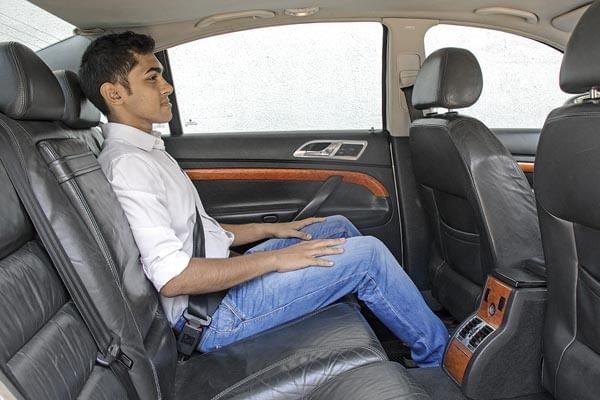
What the Superb is really all about, though, is comfort and rear passenger space. Settling down into the rear seat even today, nearly 10 years down the line, is still a real treat. The easy access to the rear seat, the room on offer, the angle of the backrest, are all near perfect. I am sat a bit low, possibly due to the coupé-like roof, and visibility isn’t great, but the overall impression of the car is so good, you tend to overlook these little flaws.
What I also notice is this car is full of kit. This includes the signature umbrella holder in the door (replete with a drainage system for water from wet umbrellas), that’s been carried over to the future models, red night-time pilot lights that provide unobtrusive illumination, a sunshade at the rear, automatic rain-sensing wipers, an auto-dimming rear-view mirror and even electronic stability control. A lot of these features are standard on cars today, but back then, they were a huge deal; right up there with stuff you only got on a Mercedes.
The Superb, however, was about more than just passenger comfort. The performance afforded by the two engine options – a 2.8-litre V6 petrol and a 2.5-litre V6 diesel – was quite impressive too. The petrol engine has an incredible five-valves-per-cylinder, and the diesel motor makes do with four valves per cylinder. We drove the diesel, and it was quite agreeable even after all these years, with creamy power gushing out, especially in the mid-range. The handling and ride was a bit of a let-down, with the former being unpredictable and the latter a bit lumpy.
Stretching it out:
B6 (2009-2016)

Most striking about the second-gen Superb are its looks; but not in a nice way. There is something distinctly off about the proportions of this car, what with its stubby nose, long roof and steep C-pillar. There is, however, method to the madness. The nose is stubby on account of the engine now being transversely placed, the long roof helps maximise the length of the cabin and the steep C-pillar is designed to improve headroom for the sat-upright rear passengers. This Superb is basically a stretched Octavia (Laura in India), and though it has a shorter wheelbase than the first-gen car, it actually feels much more spacious on the inside.
While the B5 saw a good measure of success, it was the B6 that really catapulted the Superb to stardom. It’s even more sumptuous on the inside than its predecessor. The rear seats are beautifully sculpted, with near-perfect amounts of shoulder, back and thigh support, and legroom too is superfluous. The rear, in fact, seemed more like a lounge to me and the electronically-retractable blinds, footrests, many cupholders, and B-pillar-mounted AC blowers feel extremely indulgent too. It even came with a touchscreen, which, back in 2009, was really something. The most interesting feature on the second-generation Superb, though, is the TwinDoor boot lid. Skoda didn’t want to re-engineer the entire rear end of the Octavia, so in addition to the hatch, it even opens like a boot.
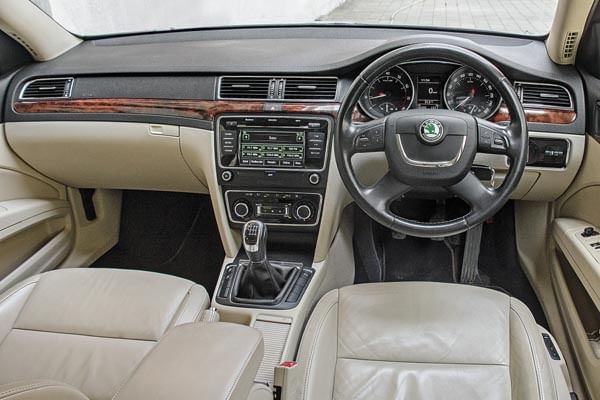
Under the hood, the mainstay petrol unit, this time around, wasn’t a V6, but a mere 1.8 turbo petrol. But what a motor it is! We drove the petrol, mated to a six-speed manual, and rest assured, the absence of a V6 was soon forgotten after a mere run up to the redline. Even today, it offers a seminal driving experience, the motor possessing huge reserves of punch, plenty of zing and boundless energy. There is a bit of turbo lag, initially, below 2,000rpm and a hint of hesitation as well, but the petrol engine was so good that it actually sold more than the diesel variant for most of the car’s life cycle, and made Honda’s 2.4, that powered the Accord, look distinctly ordinary.
The ride is also very pliant and comfortable, and what’s great is that it even drives brilliantly. There seems to be a direct connection between all four wheels and the steering. The car shrinks down to the size of a big hatchback when you attack corners and gives you so much confidence – you are soon driving its wheels off, not remembering for even a second that it is just huge.
Every rose, however, has its thorn and in the second-gen Superb, it came in the form of the faulty DSG gearboxes fitted to it. These automatic gearboxes were plagued with failures, blemishing an otherwise unspoiled experience.
Thorn of the rose

The second-generation Superb came very close to being an ideal car when a widespread problem with the DQ200 DSG gearbox fitted to many units made life difficult for owners. Multiple failures with this gearbox became routine. This was narrowed down to the sulphur in the synthetic gear oil, which, along with iodine in its plastic parts, caused electrolytic corrosion of metal surfaces. This, in turn, caused conducting particles to settle between the circuit paths of the control unit, leading to a short circuit and consequent gearbox failure.
Back in business:
B8 (2016-present)

The latest Superb, is the best looking of them all. This is quite clear in the flesh, its sharp lines, coupled with bulging fenders and crystalline tail-lights make it look way more expensive than it is. The largest and longest iteration of VW’s flexible MQB platform currently in existence, the new Superb even galvanises buyers from even higher up in the price band.
On the inside, the feeling of space is as good as ever, and the new Superb feels even wider. The rear seat, however, is only just about as good as that of the second-gen car. And there also is a slight dearth of indulgent materials. The use of wood, chrome and other decorative bits have been reduced and this car’s dash is very similar to the Octavia’s. Still, quality, fit and build are much better and the way the doors shut elevates this new car to a distinctly higher quality level. Clever features scattered throughout the car also really enhance user experience. There’s stuff like the side luggage box, nets and hooks in the boot, a tablet holder in the front armrest, a little dustbin in the driver-side door’s cubbyhole, small phone holders on the sides of the front seats and finally, two umbrellas, stowed in the front doors this time around. The expanded feature list includes a three-zone climate control, a humidity sensor, a gesture-controlled boot that opens when you swipe your leg under the car and a system that prevents the hatch-type boot lid from scraping garage ceilings by restricting its opening height.
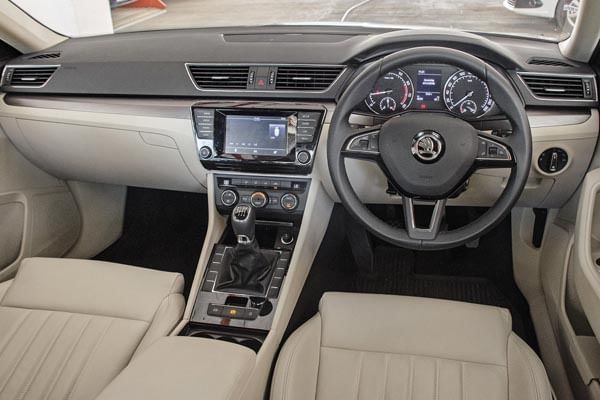
Where this car really overshadows its predecessors is in the ride. The suspension setup is softer than the previous generations’, and this translates to a smooth, unperturbed ride. Bumps and edges are just swallowed whole. The third-gen Superb comes with the same 1.8-litre petrol and 2.0-litre diesel as before. The petrol engine we drove is as enjoyable as ever, with a strong mid-range and top-end. The drive is smooth, refined and quick and once again, the performance is surprising for a car of this size. It may not handle or drive as well as the earlier generation cars, and it does feel a bit less plush, but it definitely has taken the Superb’s game forward.
Copyright (c) Autocar India. All rights reserved.



Comments
Member Login
Personal Details
No comments yet. Be the first to comment.